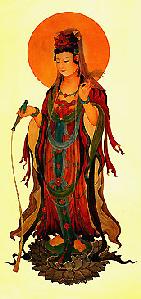Delivered at the University of Hawaii
Honolulu, Hawaii February 26, 1982 Co-sponsored by Kuan-yin Temple

Dear friends:
The Bodhisattva Kuan-yin made a great vow to release all sentient beings in the universe from suffering. Numerous miraculous events have been attributed to Kuan-yin all over the world. Because of the intimate relation that he has with us, it is taught that by undertaking his method of cultivating realization, one will obtain swift success.
There is an important passage in the Shurangama Sutra in which Bodhisattva Kuan-yin relates how he cultivated realization. In that sutra, twenty-five bodhisattvas, in response to the inquiry of Buddha Shakyamuni, explained their methods of cultivation and spiritual attainment. Afterwards, the Buddha asked Bodhisattva Manjushri to evaluate what had been said. Manjushri pointed out that Kuan-yin’s way of cultivating realization through hearing was best suited for the people of this world.
So it is because of these reasons that I have chosen the enlightenment of Bodhisattva Kuan-yin as the topic of today’s talk.
Before we discuss Bodhisattva Kuan-yin’s method, it is important that we should have some fundamental understanding about the teachings of the Buddha.
The aim of Buddha’s teachings is to release all sentient beings from suffering. The essential point is that all human suffering results from our deluded attachment, which in turn is the product of our object-clinging mind.
Here, ‘object’ means all objects of consciousness, whether they are in the outside world as perceived by our sense organs and skin, or in the inside world of our thoughts, ideas, knowledge, etc. ‘Clinging’ means grasping or becoming attached. Therefore the object-clinging mind is the state of mind through which we become attached to objects we encounter, and come to believe that those objects are real. Such attachment is deluded attachment. Because of this deluded attachment, our judgment is confounded. Ignorance, greed, hatred, and suffering result. In short, much of our experience of life is based on assumptions and perceptions which are actually contrary to reality.
To reverse this process, Buddha taught various methods to stop clinging to objects and to contemplate reality with a one-pointed mind. This is the key concept involved in ‘dhyana’ which is incompletely translated as ‘meditation.’ The practice of meditation is not just sitting like a block of wood or stone; rather, it is the act of learning to concentrate one’s mental energies in a state of absorption. This state is achieved in stages, like an ascent to one peak after another. The goal is not reached until one day you suddenly discover that all your deluded attachments have gone like the wind, leaving not a trace, or even a name to hang onto.
To begin my discussion of Kuan-yin’s method of cultivation, I would like to present first my translation of the passage from the Shurangama Sutra where he explained his meditation technique to the Buddha:
First I (concentrated) on the audial consciousness, allowed the sounds that were contacting (the ear) to flow off, and thus audial objects subsided and were lost.
Then, since ear-contact and audial objects produced no effect, the mind remained in a state of clarity, and the phenomena of motion and stillness no longer occurred.
Meditative absorption gradually deepened; ultimately the distinction between audial consciousness and the objects of audial consciousness was no longer in existence.
Although there was no experience of audial consciousness, meditative absorption continued to deepen.
Then, all awareness and objects of awareness became empty.
The awareness of emptiness expanded without boundary; then emptiness and that which is empty became extinct.
Since all arising and subsiding had ceased, equanimity became manifest.
Suddenly, transcending both the mundane and supramundane, there was an undistracted luminosity in all the ten directions.
As is evident, Kuan-yin’s method is based on the process of hearing. Before proceeding with a discussion of the technique, we should first have a clear understanding of the following five terms: ‘I,’ ‘the nature to hear,’ ‘audial consciousness,’ ‘hearing,’ and ‘sound.’ I might also state here that these five terms correspond to five degrees of deluded attachment, the coarsest and weakest of which is sound, and the subtlest and strongest of which is our ‘I.’ The latter is the most difficult one to eradicate. Ordinarily we tend to confuse sound, hearing, audial consciousness, and the nature to hear. But actually there are some important and fundamental differences.
Kuan-yin began his cultivation of realization by recognizing those differences. He practiced meditation by the sea. Every morning, when he woke up and everything was quiet about him, he would hear the sound of the tide coming in from afar, breaking the silence. After a while the sound of the tide receded and he would hear the silence restored. Then, the sound of the tide came again, and again the silence was gone. Kuan-yin studied the coming and going of the sound of the tide and discovered that the two objects the sound of the tide and the silence – were mutually exclusive, that is, he could not hear them both at once. When the sound of the tide arose, silence ceased. When the sound of the tide ceased, silence arose. Nonetheless, he perceived that they both had something in common: both arose and then ceased; both were impermanent. But not so his innate nature to hear itself; it was always present. The nature to hear enabled him to hear the sound of the incoming tide, but it did not go away when the tide went back out, for then he heard the silence. Indeed, if it were otherwise and his nature to hear were to have departed with the tide, then he would not only have not heard the silence, but he would not have heard the next tidal advance either. Thus, although the sound of the tide came and went, the nature to hear itself was not subject to those changes.
It is important to realize that while sound just comes and goes, arises and subsides, we ordinarily “pursue” sound’s transient pattern of arising and cessation; that is to say, we seize upon it as being entirely real, and therefore develop deluded attachment. In order to impress you more deeply with this crucial point, let me give an example.
Suppose that someone rings a bell. If he then asks if the bell is ringing, one would answer affirmatively. If he were to ask the same question after the ringing had faded away, one would answer in the negative. Here, language is well in accord with what has actually taken place, for the sound of the bell has, in fact, arisen and subsided. But now, if the bell is made to ring again and the question posed is “Can you hear something?” the situation becomes quite different. While the affirmative answer made while the bell continues to ring would still be correct, the same cannot be said of the negative response given when the ringing has ceased. It is true that one no longer hears the bell, but one can still hear. Even if one is aware of no sound at all, it is precisely by using the sense of hearing that one is aware of silence. So it is clear that while sound just comes and goes, the same is not true of our innate nature to hear. This aspect of hearing, which hears transient sounds, but does not itself change, is what is called the innate nature to hear in Buddhist terminology.
The examples given above serve to illustrate the difference between sound and the nature to hear. Sound arises and ceases without lingering for even a moment. It is impermanent. The nature to hear, on the other hand, is always present; it neither arises nor ceases. Even a deaf man possesses the nature to hear, but due to other impairments he cannot hear sounds.
What then is meant by audial consciousness and how does it differ from hearing?
As we all know, the organ through which we hear sounds is the ear. To be more precise, sound waves from external sources cause the eardrum to vibrate, and this in turn stimulates the audial nerves, which in one’s brain give rise to the sensation of hearing. Thus, hearing is the process whereby the nature to hear is stimulated to produce a sensation of sound through the activity of the ear and the brain. Nonetheless, sometimes the sensation of sound may even be produced without the activity of the ear. Over two decades ago, a certain Dr. Vincent, in Montreal, Canada, conducted experiments on the human brain in which he made a small opening in the skull of a woman and touched a particular part of her brain with a pair of very fine electrodes. Suddenly, the woman said that she heard someone singing a familiar song, although there was no one actually singing at the time. When the electrodes were removed, the singing stopped. When the same point was touched again, the singing commenced anew. It is obvious that in this case the sensation of the song was produced through the sole agency of the brain without the use of the ear. This part of the hearing process is called ‘audial consciousness.’ It is the consciousness of sound itself and can exist with or without the existence of an external sound and the physical ear. Another example of audial consciousness is what one hears in a dream.
The foregoing discussion clarifies, I think, the four terms used in connection with the process of hearing. To sum them up once more, then, the ‘nature to hear’ is one’s ever-present ability to hear. It neither comes nor goes; neither arises nor subsides. ‘Hearing’ is the audial process that comes about through the activity of the ear and brain. ‘Audial consciousness’ is the aspect of hearing that functions solely through the agency of the brain. ‘Sound’ is the object of hearing, whether it be the actual object perceived through the activity of both the ear and brain, or the audial object perceived by the brain alone. It comes and goes, arises and then subsides. In fact, every sound is actually a series of momentary vibrations, each of which has its arising and cessation. Having comprehended these four concepts in this way, we may proceed to discuss Kuan-yin’s way of cultivating realization.
